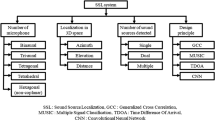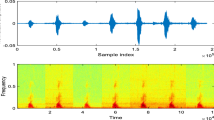Abstract
Acoustic echo cancellation (AEC) in voiced communication systems is used to eliminate the echo which corrupts the speech signal and reduces the efficiency of signal transmission. Usually, the performance of AEC system based on the adaptive filtering degrades seriously in the presence of speech issued from the near-end speaker (double-talk). In typical AEC scenarios, double-talk detector (DTD) must be added to AEC for improving speech quality. One of the main problems in AEC with DTD is that the DTD errors can result in either large residual echo or distorting the near-end input speech. Considering the strong correlation property of speech signals, this paper presents a novel proportionate decorrelation normalized least-mean-square (PDNLMS) adaptive AEC without DTD for echo cancellation as an interesting alternative to the typical AEC with DTDs. Unlike traditional AEC with a DTD, the proposed PDNLMS uses the difference of near-end speech as the residual error to update adaptive echo channel filter during the periods of double-talk, which can efficiently reduce the double-talk influence on the AEC adaptation process. The experimental results show that not only the proposed PDNLMS without DTD illustrate better stability and faster convergence rate, but it is also of a lower steady-state misalignment and better residual signal than current methods with DTDs at a lower computational cost.







Similar content being viewed by others
References
J. Benesty, D.R. Morgan, J.H. Cho, A new class of doubletalk detectors based on cross-correlation. IEEE Trans. Speech Audio Process. 8(2), 168–172 (2000)
J. Benesty, H. Rey, L.R. Vega, S. Tressens, A nonparametric vss nlms algorithm. IEEE Signal Process. Lett. 13(10), 581–584 (2006)
J.H. Cho, D.R. Morgan, J. Benesty, An objective technique for evaluating doubletalk detectors in acoustic echo cancelers. IEEE Trans. Speech Audio Process. 7(6), 718–724 (1999)
H. Deng, M. Doroslovacki, Proportionate adaptive algorithms for network echo cancellation. IEEE Trans. Signal Process. 54(5), 1794–1803 (2006)
D.L. Duttweiler, A twelve-channel digital echo canceler. IEEE Trans. Commun. 26(5), 647–653 (1978)
D.L. Duttweiler, Proportionate normalized least-mean-squares adaptation in echo cancelers. IEEE Trans. Speech and Audio Process. 8(5), 508–518 (2000)
J. Fu, W. Zhu, A nonlinear acoustic echo canceller using sigmoid transform in conjunction with RLS algorithm. IEEE Trans. Circuts Syst. Express Briefs 55(10), 1056–1060 (2008)
T. Gansler, J. Benesty, A frequency-domain double-talk detector based on a normalized cross-correlation vector. Signal Process. 81, 1783–1787 (2001)
T. Gansler, J. Benesty, The fast normalized cross-correlation double-talk detector. Signal Process. 86, 1124–1139 (2006)
S.L. Gay, S. Tavathia, M. Hill, The Fast Affine Projection Algorithm (Springer, US, 2000)
K. Ghose, V.U. Reddy, A double-talk detector for acoustic echo cancellation applications. Signal Process. 80, 1459–1467 (2000)
J.D. Gordy, R.A. Goubran, A low-complexity doubletalk detector for acoustic echo cancellers in packet-based telephony. In: IEEE Workshop on Applications of Signal Processing to Audio and Acoustics, pp. 74–77 (2005)
A. Guerin, G. Faucon, R. Le Bouquin-jeanns, Nonlinear acoustic echo cancellation based on volterra filters. IEEE Trans. Speech Audio Process. 11(6), 672–683 (2003)
S. Gustafsson, R. Martin, P. Jax, P. Vary, A psychoacoustic approach to combined acoustic echo cancellation and noise reduction. IEEE Trans. Speech Audio Process. 10(5), 245–256 (2002)
Simon Haykin, Adaptive Filter Theory (Prentice-Hall, New Jersey, 2002)
H.C. Huang, J. Lee, A new variable step-size NLMS algorithm and its performance analysis. IEEE Trans. Signal Process. 60(4), 2055–2060 (2012)
H.K. Jung, N.S. Kim, T. Kim, A new double-talk detector using echo path estimation. Speech Commun. 45, 41–48 (2005)
A. Mader, H. Puder, G.U. Schmidt, Step-size control for acoustic echo cancellation-an overview. Signal Process. 80, 1697–1719 (2000)
C. Paleologu, J. Benesty, S. Ciochin, A variable step-size affine projection algorithm designed for acoustic echo cancellation. IEEE Trans. Audio Speech Lang. Process. 16(8), 1466–1478 (2008)
Y.S. Park, J.H. Chang, Double-talk detection based on soft decision for acoustic echo suppression. Signal Process. 90, 1737–1741 (2010)
T. Shao, Y.R. Zheng, J. Benesty, An affine projection sign algorithm robust against impulsive interferences. IEEE Signal Process. Lett. 17(4), 327–330 (2010)
H.C. Shin, A.H. Sayed, W.J. Song, Variable step-size NLMS and affine projection algorithms. IEEE Signal Process. Lett. 11(2), 132–135 (2004)
G. Szwoch, A. Czyzewski, M. Kulesza, A low complexity double-talk detector based on the signal envelope. Signal Process. 88(11), 2856–2862 (2008)
H. Wen, X. Lai, L. Chen, Z. Cai, An improved proportionate normalized least mean square algorithm for sparse impulse response identification. J. Shanghai Jiaotong Univ. 18(6), 742–748 (2013)
Z. Yang, Y.R. Zheng, S.L. Grant, Proportionate affine projection sign algorithms for network echo cancellation. IEEE Trans. Audio Speech Lang. Process. 19(8), 2273–2284 (2011)
J. Zhang, H.M. Tai, Adaptive noise cancellation algorithm for speech processing, IECON 2007–33rd Annu. Conf. IEEE Ind. Electron. Soc. 2489–2492 (2007)
J. Zhang, Least mean square error difference minimum criterion for adaptive chaotic noise canceller. Chin. Phys. 16(2), 352–358 (2007)
Acknowledgments
This work was partially supported by National Science Foundation of P.R. China (Grant: 61271341).
Author information
Authors and Affiliations
Corresponding author
Rights and permissions
About this article
Cite this article
Pu, K., Zhang, J. & Min, L. A Signal Decorrelation PNLMS Algorithm for Double-Talk Acoustic Echo Cancellation. Circuits Syst Signal Process 35, 669–684 (2016). https://doi.org/10.1007/s00034-015-0059-8
Received:
Revised:
Accepted:
Published:
Issue Date:
DOI: https://doi.org/10.1007/s00034-015-0059-8




